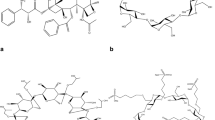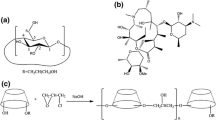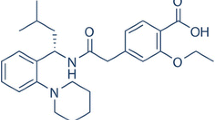Abstract
The objective of this study was to improve poor aqueous solubility and dissolution properties of anticancer drug rapamycin through formation of inclusion complexes with natural and modified cyclodextrins. Of the cyclodextrins tested, γ-cyclodextrin and hydroxypropyl-γ-cyclodextrin did not complex with rapamycin. However, complexes of rapamycin with β-cyclodextrin, methyl-β-cyclodextrin and hydroxypropyl-β-cyclodextrin were prepared and characterized by techniques such as Fourier Transform infrared spectroscopy, differential scanning calorimetry, phase solubility analysis and in vitro dissolution studies. According to the characterization data for the complexes, rapamycin water solubility was highly enhanced by all three β-cyclodextrins with methyl-β-cyclodextrin complex resulting in particularly higher solubility enhancement. FTIR spectra and DSC thermograms supported the formation of inclusion complexes. The complexes showed highly improved dissolution rate in water. Complexation with cyclodextrin derivatives such as methyl-β-cyclodextrin and hydroxypropyl-β-cyclodextrin can provide promising alternatives for the formulation of rapamycin.







Similar content being viewed by others
Abbreviations
- CD:
-
Cyclodextrin
- βCD:
-
β-Cyclodextrin
- MβCD:
-
Methyl-β-cyclodextrin
- HPβCD:
-
Hydroxypropyl-β-cyclodextrin
- γCD:
-
γ-Cyclodextrin
- HPγCD:
-
Hydroxypropyl-γ-cyclodextrin
- Rapa:
-
Rapamycin
References
Baker, H., Sidorowicz, A., Sehgal, S.N.: Rapamycin (AY-22, 989), a new antifungal antibiotic. III. In vitro and in vivo evaluation. J. Antibiot. (Tokyo) 31, 539–545 (1978)
Martel, R.R., Klicius, J., Galet, S.: Inhibition of the immune response by rapamycin, a new antifungal antibiotic. Can. J. Physiol. Pharmacol. 55, 48–51 (1977)
Collier, S.J.: Immunosuppressive drugs. Curr. Opin. Immunol. 2, 854–858 (1989)
Dumont, F.J., Staruch, M.J., Koprak, S.L., Melino, M.R., Sigal, N.H.: Distinct mechanisms of suppression of murine T cell activation by the related macrolides FK-506 and rapamycin. J. Immunol. 144, 251–258 (1990)
Woltman, A.M., van der Kooij, S.W., Coffer, P.J., Offringa, R., Daha, M.R., van Kooten, C.: Rapamycin specifically interferes with GMCSF signaling in human dendritic cells, leading to apoptosis via increased p27KIP1 expression. Blood 101, 1439–1445 (2003)
Eng, C.P., Sehgal, S.N., Vezina, C.: Activity of rapamycin (AY-22, 989) against transplanted tumors. J. Antibiot. (Tokyo) 37, 1231–1237 (1984)
Yatscoff, R.: Pharmacokinetics of rapamycin. Transplant Proc. 28, 970–973 (1996)
Rapamune® Label and Patient Information, Wyeth Pharmaceuticals Inc. Philadelphia, PA 19101. http://www.accessdata.fda.gov/drugsatfda_docs/label/2004/21083s017,21110s020lbl.pdf (2010). Accessed 29 June 2010
De, T., Trieu, V., Yim, Z., Cordia, J., Yang, A., Beals, B., Ci, S., Louie, L., Desai, N.: Nanoparticle albumin-bound (nab) rapamycin as an anticancer agent [abstract]. In: Proceedings of the 98th Annual Meeting of the American Association for Cancer Research, Los Angeles, Meeting Abstracts, 14–18 April 2007
Alemdar, A.Y., Sadi, D., McAlister, V.C., Mendez, I.: Liposomal formulations of tacrolimus and rapamycin increase graft survival and fiber outgrowth of dopaminergic grafts. Cell Transplant. 13, 263–271 (2004)
Rouf, M.A., Vural, I., Renoir, J.-M., Hincal, A.A.: Development and characterization of liposomal formulations for rapamycin delivery and investigation of their antiproliferative effect on MCF7 cells. J. Liposome Res. 19(4), 322–331 (2009)
Buech, G., Bertelmann, E., Pleyer, U., Siebenbrodt, I., Borchert, H.H.: Formulation of sirolimus eye drops and corneal permeation studies. J. Ocul. Pharmacol. Ther. 23, 292–303 (2007)
Forrest, M.L., Won, C.Y., Malick, A.W., Kwon, G.S.: In vitro release of the mTOR inhibitor rapamycin from poly(ethylene glycol)-b-poly(epsilon-caprolactone) micelles. J. Control Release 110, 370–377 (2006)
Kipshidze, N.N., Porter, T.R., Dangas, G., Yazdi, H., Tio, F., Xie, F., Hellinga, D., Wolfram, R., Seabron, R., Waksman, R., Abizaid, A., Roubin, G., Iyer, S., Colombo, A., Leon, M.B., Moses, J.W., Iversen, P.: Novel site-specific systemic delivery of Rapamycin with perfluorobutane gas microbubble carrier reduced neointimal formation in a porcine coronary restenosis model. Catheter Cardiovasc. Interv. 64, 389–394 (2005)
Brara, P.S., Moussavian, M., Grise, M.A., Reilly, J.P., Fernandez, M., Schatz, R.A., Teirstein, P.S.: Pilot trial of oral rapamycin for recalcitrant restenosis. Circulation 107, 1722–1724 (2003)
Ray, G.M., Nawarskas, J.J., Frishman, W.H.: The paclitaxel-eluting stent in percutaneous coronary intervention: part II: Comparison with the sirolimus-eluting stent, economics, and unanswered questions. Cardiol. Rev. 14, 143–150 (2006)
Pires, N.M., van, der Hoeven, B.L., de Vries, M.R., Havekes, L.M., van Vlijmen, B.J., Hennink, W.E., Quax, P.H., Jukema, J.W.: Local perivascular delivery of anti-restenotic agents from a drug-eluting poly(epsilon-caprolactone) stent cuff. Biomaterials 26, 5386–5394 (2005)
Sousa, J.E., Sousa, A.G., Costa, M.A., Abizaid, A.C., Feres, F.: Use of rapamycin-impregnated stents in coronary arteries. Trans. Proc. 35, 165S–170S (2003)
Wang, X., Venkatraman, S.S., Boey, F.Y., Loo, J.S., Tan, L.P.: Controlled release of sirolimus from a multilayered PLGA stent matrix. Biomaterials 27, 5525–5588 (2006)
Szente, L., Szejtli, J.: Highly soluble cyclodextrin derivatives: chemistry, properties, and trends in development. Adv. Drug Deliv. Rev. 36, 17–38 (1999)
Challa, R., Ahuja, A., Ali, J., Khar, R.K.: Cyclodextrins in drug delivery: an updated review. AAPS Pharm. Sci. Tech. 6, E329–E357 (2005)
Higuchi, T., Connors, K.A.: Phase-solubility techniques. Adv. Anal. Chem. Instrum. 4, 117–212 (1965)
Nogami, H., Nagai, T., Yotsuyanagi, Y.: Dissolution phenomena of organic medicinals involving simultaneous phase change. Chem. Pharm. Bull. 17, 499–509 (1969)
Trapani, G., Latrofa, A., Franco, M., Pantaleo, M.R., Sanna, E., Massa, F., Tuveri, F., Liso, G.: Complexation of zolpidem with 2-hydroxypropyl-ß-, methyl-ß-, and 2-hydroxypropyl-γ-cyclodextrin: effect on aqueous solubility, dissolution rate, and ataxic activity in rat. J. Pharm. Sci. 89, 1443–1451 (2000)
Ferron, G.M., Conway, W.D., Jusko, W.J.: Lipophilic benzamide and anilide derivatives as high-performance liquid chromatography internal standards: application to sirolimus(rapamycin) determination. J. Chromatog. B 703, 243–251 (1997)
Holt, D.W., Lee, T., Jones, K., Johnston, A.: Validation of an assay for routine monitoring of sirolimus using HPLC with mass spectrometric detection. Clin. Chem. 46, 1179–1183 (1997)
Uekama, K.: Pharmaceutical applications of methylated cyclodextrins. Pharm. Int. 6, 61–65 (1985)
Liu, L., GUO, Q.-X.: The driving forces in the inclusion complexation of cyclodextrins. J. Incl. Phenom. Macrocycl. Chem. 42, 1–14 (2002)
Otero-Espinar, F., Anguiano-Igea, S., Garcia-Gonzalez, J., Vila-Jato, J., Blanco-Mendez, J.: Interaction of naproxen with b-cyclodextrin in solution and in the solid state. Int. J. Pharm. 79, 149–157 (1992)
Kacso, I., Borodi, G., Farcas, S. I., and Bratu, I: Inclusion compound of vitamin B13 in β-Cyclodextrin. J. Phys.: Conference Series 182 (2009). doi:10.1088/1742-6596/182/1/012009
Hassan, M., Suleiman, M., Najib, N.: Improvement of the in vitro dissolution characteristics of famotidine by inclusion in b-cyclo-dextrin. Int. J. Pharm. 58, 19–24 (1990)
Marques, H.C., Hadgraft, J., Kallaway, I.: Studies of cyclodextrin inclusion complexes. I. The salbutamol–cyclodextrin complex as studied by phase solubility and DSC. Int. J. Pharm. 63, 259–266 (1990)
Szejtli, J.: Medicinal applications of cyclodextrins. Med. Res. Rev. 14, 353–386 (1994)
Acknowledgments
Authors wish to thank Dr. Christoph Winterhalter-Wacker Chemie AG, Germany for the kind supply of CAVASOL® products used in this study. Prof. Murat Şen from Department of Polymer Chemistry, Chemistry Division, Hacettepe University-Ankara is acknowledged for his assistance in FTIR and DSC analysis. Mr. Erhan Vargun of Varpa Co. Ltd, Ankara is also acknowledged for his support during the study.
Author information
Authors and Affiliations
Corresponding author
Rights and permissions
About this article
Cite this article
Abdur Rouf, M., Vural, I., Bilensoy, E. et al. Rapamycin-cyclodextrin complexation: improved solubility and dissolution rate. J Incl Phenom Macrocycl Chem 70, 167–175 (2011). https://doi.org/10.1007/s10847-010-9885-2
Received:
Accepted:
Published:
Issue Date:
DOI: https://doi.org/10.1007/s10847-010-9885-2




